Divergence Trading: Complete Guide to Technical Analysis
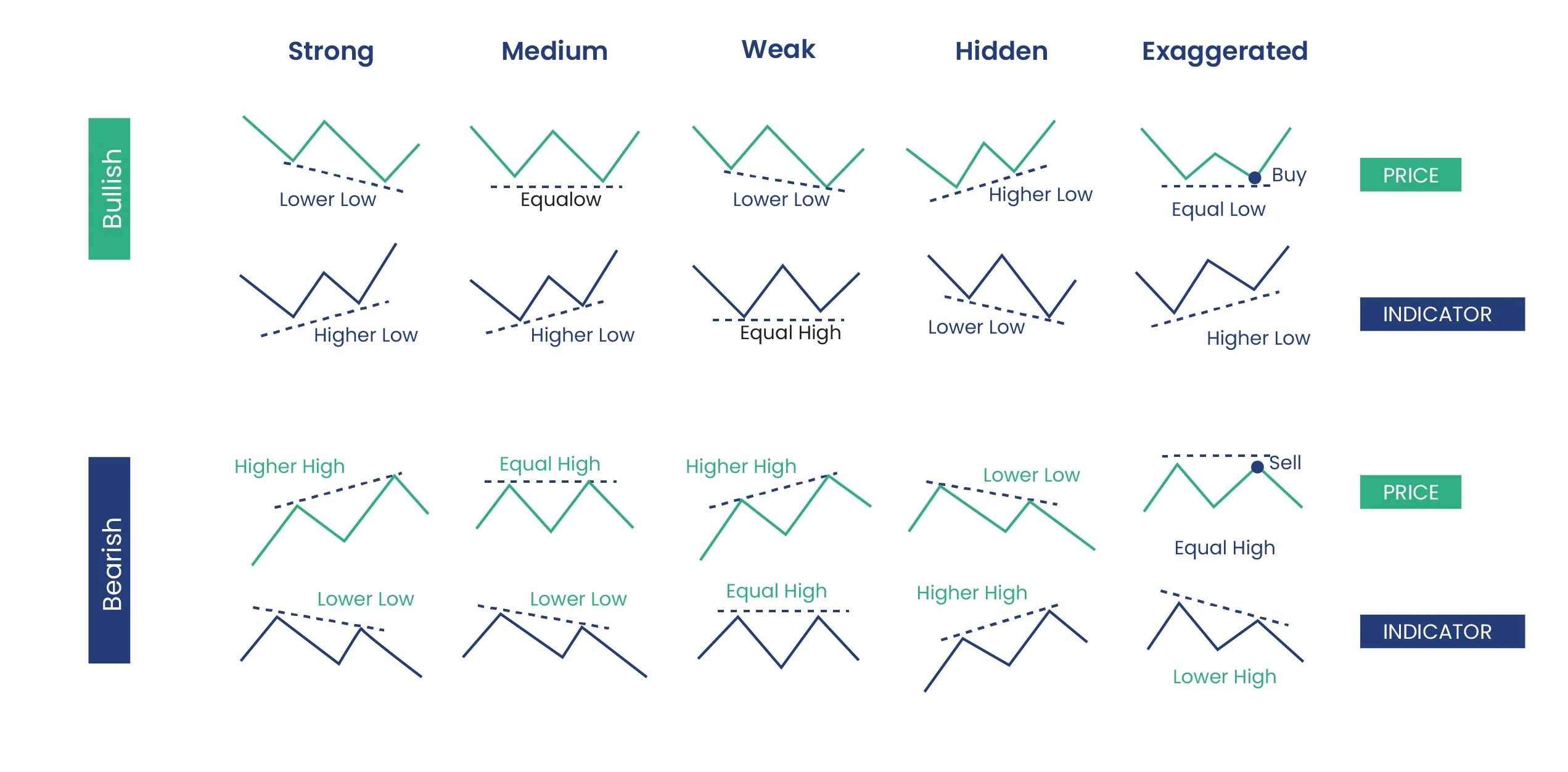
What is Divergence in Technical Analysis?
Divergence is a powerful technical analysis concept that occurs when the price of an asset moves in the opposite direction of a momentum oscillator such as RSI, MACD, or Stochastic. This disagreement between price action and momentum indicators often signals potential trend reversals or continuations, making it one of the most valuable tools in a trader's arsenal.
Unlike simple overbought or oversold signals, divergence provides early warning signs of momentum shifts before they become apparent in price movements. This predictive nature makes divergence analysis particularly valuable for identifying high-probability entry and exit points in various market conditions.
Professional traders and institutional investors frequently use divergence analysis to gauge market sentiment and identify potential turning points. By understanding when momentum is weakening despite continued price movement in one direction, traders can position themselves ahead of major market reversals and profit from these strategic opportunities.
Types of Divergence Patterns
Divergence patterns are classified into two main categories: Regular Divergence and Hidden Divergence. Each type provides different insights into potential market behavior and requires specific trading approaches for optimal results.
Divergence Quick Reference Table
| Divergence Type | Price Action | Indicator Action |
|---|---|---|
| Bullish Regular | Lower Low (LL) | Higher Low (HL) |
| Bearish Regular | Higher High (HH) | Lower High (LH) |
| Bullish Hidden | Higher Low (HL) | Lower Low (LL) |
| Bearish Hidden | Lower High (LH) | Higher High (HH) |
Regular Divergence: Trend Reversal Signals
Regular divergence indicates potential trend reversals and occurs when price and momentum move in opposite directions. This type of divergence is most effective at identifying major turning points in the market.
Bullish Regular Divergence
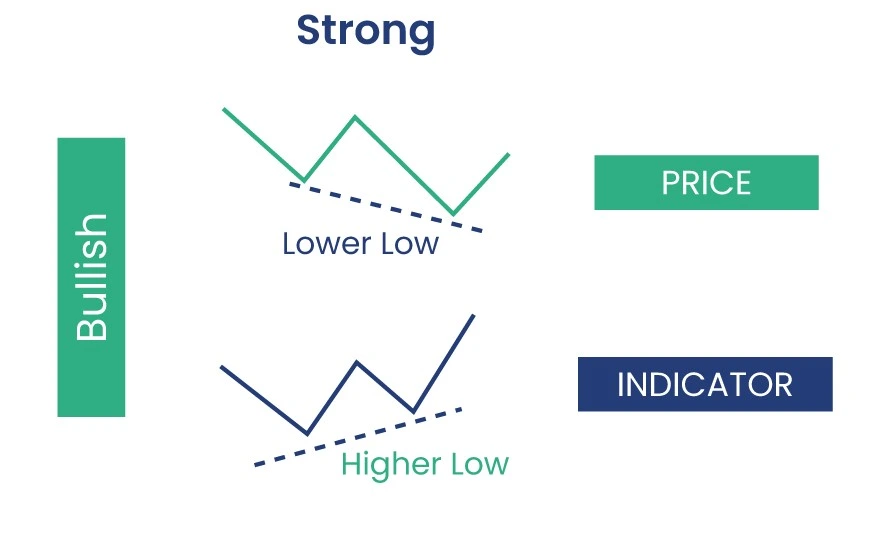
Bullish regular divergence forms when the price creates lower lows while the momentum oscillator (RSI, MACD, or Stochastic) creates higher lows. This pattern suggests that selling pressure is weakening and a potential upward reversal may be imminent.
Key characteristics of bullish regular divergence:
- Price continues to decline, making new lower lows
- The momentum indicator fails to confirm the new lows
- The indicator creates higher lows, showing weakening downside momentum
- Often occurs in oversold territory (RSI below 30)
- Signals potential buying opportunity when confirmed
Bearish Regular Divergence
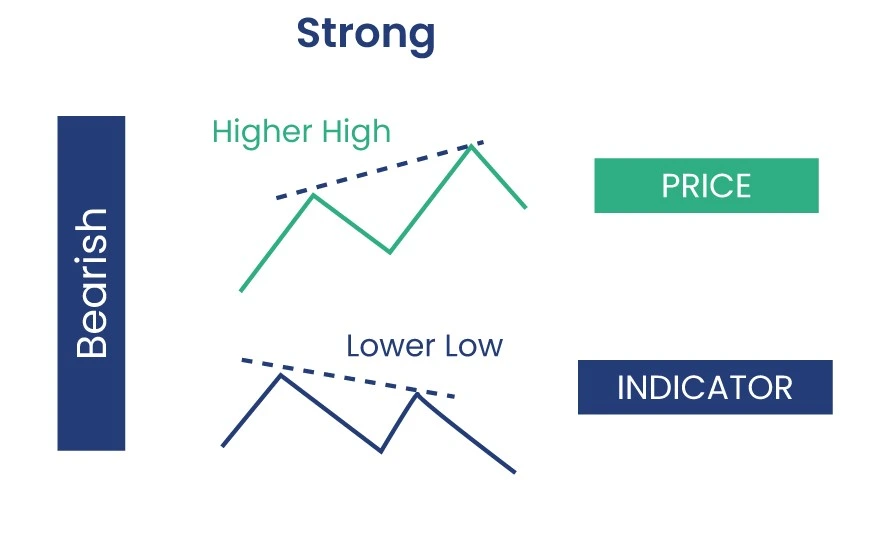
Bearish regular divergence occurs when the price creates higher highs while the momentum oscillator creates lower highs. This pattern indicates that buying pressure is diminishing and a potential downward reversal could be developing.
Key characteristics of bearish regular divergence:
- Price continues to rise, making new higher highs
- The momentum indicator fails to confirm the new highs
- The indicator creates lower highs, showing weakening upside momentum
- Often occurs in overbought territory (RSI above 70)
- Signals potential selling opportunity when confirmed
Hidden Divergence: Trend Continuation Signals
Hidden divergence signals trend continuation rather than reversal. This type of divergence helps traders identify temporary retracements within a strong trending market and provides opportunities to join the prevailing trend at favorable prices.
Bullish Hidden Divergence
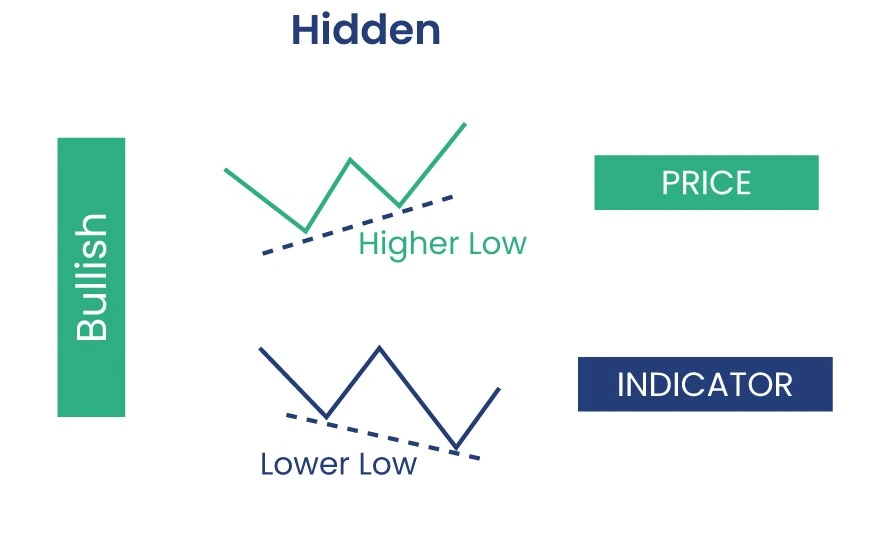
Bullish hidden divergence occurs during an uptrend when price creates higher lows while the momentum oscillator creates lower lows. This pattern suggests that the uptrend remains strong and is likely to continue after a temporary pullback.
Characteristics of bullish hidden divergence:
- Occurs within an established uptrend
- Price makes higher lows (showing trend strength)
- Momentum indicator makes lower lows
- Indicates the pullback is temporary
- Provides opportunities to add to long positions
Bearish Hidden Divergence
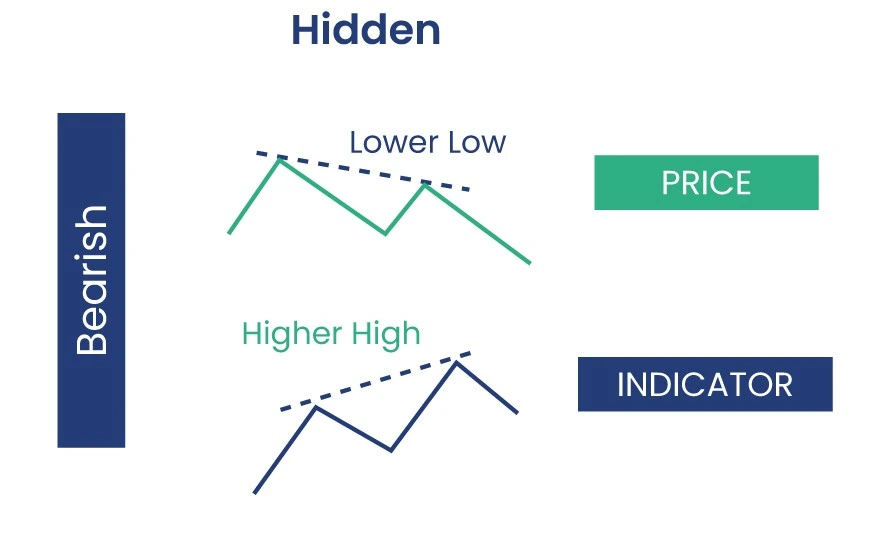
Bearish hidden divergence forms during a downtrend when price creates lower highs while the momentum oscillator creates higher highs. This pattern indicates that the downtrend maintains its strength and is likely to resume after a temporary bounce.
Characteristics of bearish hidden divergence:
- Occurs within an established downtrend
- Price makes lower highs (showing trend strength)
- Momentum indicator makes higher highs
- Indicates the bounce is temporary
- Provides opportunities to add to short positions
Key Technical Indicators for Divergence Analysis
Several momentum oscillators are particularly effective for divergence analysis. Understanding each indicator's strengths and calculations helps traders choose the most appropriate tool for different market conditions.
RSI Divergence Analysis
The Relative Strength Index (RSI) is one of the most popular indicators for divergence trading. RSI measures momentum on a scale from 0 to 100, making it ideal for spotting divergences between price action and momentum strength.
How to Use RSI for Divergence Trading
When using RSI for divergence analysis, focus on these key approaches:
- Overbought Zone (RSI > 70): Look for bearish divergence signals when price makes higher highs but RSI fails to confirm
- Oversold Zone (RSI < 30): Watch for bullish divergence when price makes lower lows but RSI shows higher lows
- Multiple Swing Analysis: Compare at least 2-3 swing points for more reliable divergence signals
- Timeframe Consideration: Higher timeframes (4H, Daily) provide more reliable RSI divergence signals
- Confirmation Required: Wait for price action confirmation before entering trades based on RSI divergence
| RSI Level | Market Condition | Divergence Focus |
|---|---|---|
| Above 70 | Overbought | Watch for Bearish Divergence |
| Below 30 | Oversold | Watch for Bullish Divergence |
| 40-60 | Neutral Zone | Look for Trend Continuation Signals |
MACD Divergence Signals
The Moving Average Convergence Divergence (MACD) indicator is excellent for identifying divergence patterns due to its dual nature as both a trend-following and momentum indicator.
How to Use MACD for Divergence Trading
MACD offers three components for divergence analysis, each providing different insights:
| MACD Component | Divergence Application | Trading Advantage |
|---|---|---|
| MACD Line | Compare swing highs/lows with price swings | Shows overall momentum divergence |
| Signal Line | Use crossovers for entry confirmation | Provides trade entry timing |
| MACD Histogram | Most sensitive for early divergence detection | Shows divergence before MACD line |
Trading Strategy: The MACD histogram often shows divergence before the main MACD line, making it particularly valuable for early signal detection. Focus on histogram divergence first, then wait for MACD line confirmation and finally look for signal line crossover as entry trigger.
Step-by-Step Divergence Identification Process
Identifying divergence patterns requires a systematic approach to ensure accuracy and reliability. Follow this comprehensive process to spot high-quality divergence signals:
Step 1: Chart Setup and Timeframe Selection
- Choose appropriate timeframes based on trading style (higher timeframes for swing trading, lower for day trading)
- Apply your preferred momentum oscillator (RSI, MACD, or Stochastic)
- Ensure both price chart and indicator are clearly visible
- Use standard indicator settings initially (RSI 14, MACD 12,26,9, Stochastic 14,3,3)
Step 2: Identify Significant Swing Points
- Look for prominent swing highs and lows in the price chart
- Focus on clear, well-defined peaks and troughs
- Ensure swing points are separated by meaningful price movement
- Mark these points on both price and indicator charts
Step 3: Compare Price and Indicator Patterns
- Draw trendlines connecting swing points on both price and indicator
- Look for instances where these trendlines slope in opposite directions
- Verify that the divergence is clear and unambiguous
- Check multiple swing points for stronger confirmation
Step 4: Classify the Divergence Type
- Determine if the pattern is regular or hidden divergence
- Identify whether it's bullish or bearish
- Consider the current trend context
- Assess the strength of the divergence signal
Step 5: Seek Additional Confirmation
- Look for supporting signals from other technical indicators
- Check volume patterns for confirmation
- Identify key support/resistance levels nearby
- Consider broader market context and sentiment
Advanced Divergence Trading Strategies
Professional traders use sophisticated approaches to maximize the effectiveness of divergence signals. These strategies combine multiple technical analysis concepts for higher probability setups.
Multi-Timeframe Divergence Analysis
Using multiple timeframes significantly improves divergence trading accuracy:
- Higher Timeframe (Daily/4H): Identify major divergence patterns for trend direction
- Lower Timeframe (1H/15M): Fine-tune entry and exit points
- Alignment Strategy: Trade only when both timeframes show complementary signals
- Confirmation Approach: Use lower timeframe to confirm higher timeframe divergence
Divergence with Support and Resistance
Combining divergence signals with key price levels increases success rates:
- Look for divergence patterns forming at major support/resistance zones
- Pay attention to divergence at Fibonacci retracement levels
- Consider divergence signals near round numbers or psychological levels
- Use previous swing highs/lows as additional confluence factors
Volume-Confirmed Divergence
Volume analysis adds another layer of confirmation to divergence signals:
- Bullish Divergence: Look for decreasing volume during price declines
- Bearish Divergence: Watch for decreasing volume during price advances
- Breakout Confirmation: Increased volume after divergence strengthens the signal
- Volume Oscillators: Use OBV (On-Balance Volume) for additional divergence analysis
Risk Management in Divergence Trading
Effective risk management is crucial for successful divergence trading. Even high-quality divergence signals can fail, making proper position sizing and stop-loss placement essential.
Position Sizing Guidelines
- Risk only 1-2% of total account balance per divergence trade
- Adjust position size based on stop-loss distance
- Consider higher conviction trades with slightly larger positions (max 3%)
- Use smaller positions for lower timeframe signals
Stop-Loss Placement Strategies
- Swing-Based Stops: Place stops beyond the relevant swing high/low
- ATR-Based Stops: Use 2-3 times the Average True Range for volatile markets
- Structure-Based Stops: Position stops beyond key support/resistance levels
- Time-Based Stops: Exit if the pattern hasn't developed within expected timeframe
Profit Target Selection
- Use minimum 1:2 risk-to-reward ratio for divergence trades
- Target previous swing highs/lows as initial profit levels
- Consider Fibonacci extension levels for extended targets
- Scale out of positions as targets are reached
Common Divergence Trading Mistakes to Avoid
Understanding and avoiding common pitfalls can significantly improve your divergence trading results:
- Trading Without Confirmation: Never trade divergence signals alone - wait for price action confirmation
- Forcing Divergence Patterns: Only trade clear, unambiguous divergence signals
- Ignoring Market Context: Consider overall trend and market conditions
- Poor Timeframe Selection: Match timeframe to trading style and patience level
- Inadequate Risk Management: Always use appropriate stop-losses and position sizing
- Over-Reliance on Single Indicators: Use multiple indicators for better confirmation
- Emotional Trading: Stick to predetermined rules and avoid impulsive decisions
Market Conditions and Divergence Effectiveness
Divergence patterns perform differently across various market conditions. Understanding these nuances helps traders adapt their strategies accordingly:
Trending Markets
- Regular Divergence: Less reliable in strong trends - price often continues despite momentum weakness
- Hidden Divergence: Highly effective for trend continuation trades
- Strategy: Focus on hidden divergence during pullbacks in strong trends
Range-Bound Markets
- Regular Divergence: Very effective at range boundaries
- Strategy: Trade regular divergence signals near support/resistance levels
- Indicators: Stochastic oscillator particularly effective in ranging conditions
Volatile/Choppy Markets
- Challenge: Increased false signals and whipsaws
- Solution: Use higher timeframes and require stronger confirmation
- Adjustment: Widen stops and reduce position sizes
Conclusion: Mastering Divergence Trading
Divergence trading represents one of the most powerful and reliable approaches in technical analysis when applied correctly. By identifying disagreements between price action and momentum indicators, traders can anticipate potential trend reversals and continuations before they become obvious to the broader market.
The key to successful divergence trading lies in understanding the different types of patterns, using appropriate technical indicators, and implementing proper risk management strategies. Regular divergence signals potential trend reversals, while hidden divergence indicates trend continuation opportunities. Each type requires specific approaches and confirmation methods for optimal results.
Remember that divergence analysis works best when combined with other technical tools such as support/resistance levels, volume analysis, and multiple timeframe confirmation. No single indicator or pattern should be traded in isolation, and successful divergence trading requires patience, discipline, and continuous learning.
As with all trading strategies, practice with historical data and paper trading before risking real capital. Focus on high-quality setups, maintain strict risk management discipline, and continuously refine your approach based on market feedback and performance analysis.